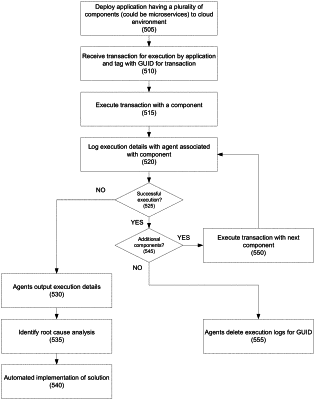| CPC G06F 11/366 (2013.01) [G06F 9/451 (2018.02); G06N 20/00 (2019.01); H04L 67/10 (2013.01)] | 14 Claims |

|
1. A method for monitoring server-side application execution, comprising:
in an information processing apparatus comprising at least one computer processor:
deploying an application having a plurality of microservices to a cloud environment, wherein each microservice is associated with an agent that collects execution information for the microservice;
executing a transaction with the application, wherein the transaction is processed by the plurality of microservices serially;
a first microservice of the plurality of microservices assigning a unique identifier to the transaction and executing a first portion of the transaction;
the agent for the first microservice collecting first portion execution information to store in a transaction log and associating the transaction log with the unique identifier, wherein the unique identifier is communicated to other agents associated with the plurality of microservices;
a second microservice of the plurality of microservices executing a section portion of the transaction;
the agent for the second microservice collecting second portion execution information to store in the transaction log associated with the unique identifier;
outputting the transaction log in response to an unsuccessful execution of the transaction to identify a root cause of the unsuccessful execution of the transaction; and
executing a remedy action selected by an analysis module using a machine learning model based on the transaction log and on prior actions,
wherein the analysis module monitors the application for an outcome of the executed action, and
adjusts the machine learning model based on the monitored outcome.
|